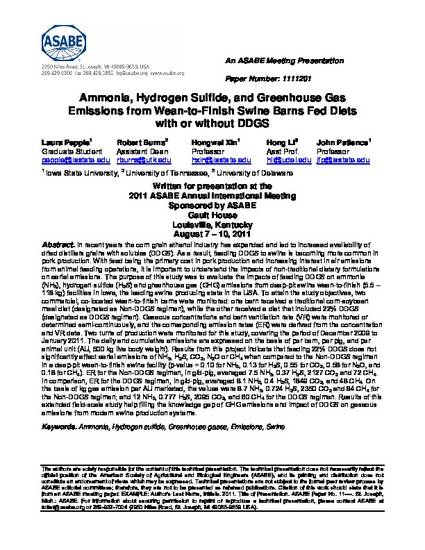
In recent years the corn grain ethanol industry has expanded and led to increased availability of dried distillers grains with solubles (DDGS). As a result, feeding DDGS to swine is becoming more common in pork production. With feed being the primary cost in pork production and increasing interest in air emissions from animal feeding operations, it is important to understand the impacts of non-traditional dietary formulations on aerial emissions. The purpose of this study was to evaluate the impacts of feeding DDGS on ammonia (NH3), hydrogen sulfide (H2S) and greenhouse gas (GHG) emissions from deep-pit swine wean-to-finish (5.5 – 118 kg) facilities in Iowa, the leading swine producing state in the USA. To attain the study objectives, two commercial, co-located wean-to-finish barns were monitored: one barn received a traditional corn-soybean meal diet (designated as Non-DDGS regimen), while the other received a diet that included 22% DDGS (designated as DDGS regimen). Gaseous concentrations and barn ventilation rate (VR) were monitored or determined semi-continuously, and the corresponding emission rates (ER) were derived from the concentration and VR data. Two turns of production were monitored for this study, covering the period of December 2009 to January 2011. The daily and cumulative emissions are expressed on the basis of per barn, per pig, and per animal unit (AU, 500 kg live body weight). Results from this project indicate that feeding 22% DDGS does not significantly affect aerial emissions of NH3, H2S, CO2, N2O or CH4 when compared to the Non-DDGS regimen in a deep-pit wean-to-finish swine facility (p-value = 0.10 for NH3, 0.13 for H2S, 0.55 for CO2, 0.58 for N2O, and 0.18 for CH4). ER for the Non-DDGS regimen, in g/d-pig, averaged 7.5 NH3, 0.37 H2S, 2127 CO2 and 72 CH4. In comparison, ER for the DDGS regimen, in g/d-pig, averaged 8.1 NH3, 0.4 H2S, 1849 CO2, and 48 CH4. On the basis of kg gas emission per AU marketed, the values were 8.7 NH3, 0.724 H2S, 2350 CO2 and 84 CH4 for the Non-DDGS regimen; and 12 NH3, 0.777 H2S, 2095 CO2, and 60 CH4 for the DDGS regimen. Results of this extended field-scale study help filling the knowledge gap of GHG emissions and impact of DDGS on gaseous emissions from modern swine production systems.
Available at: http://works.bepress.com/john-patience/4/

This is an ASABE Meeting Presentation, Paper No. 1111201.